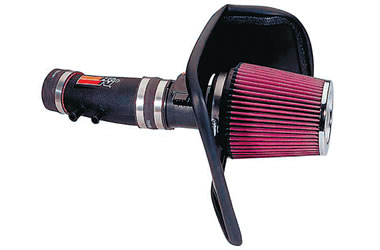An aftermarket air intake is often the first performance upgrade people make to their vehicle—and for good reason. A high performance air intake kit delivers instant horsepower gains, enhanced throttle response, and sometimes even an increase in fuel economy. Best of all, it’s one of the easiest performance parts to install, requiring only basic hand tools and minimal mechanical knowledge.
Although there’s no question that aftermarket air intakes are a quick, easy way to improve performance, you do need to ask yourself some questions before choosing a specific one for your vehicle. Once you have the answers to these questions–and after you’ve familiarized yourself with the key terms from our Air Intakes 101 post–you’ll know the right type of aftermarket air intake for your ride.
Question 1: Should I Choose a Standard or Cold Air Intake Kit?
Your intake tube and air box is responsible for feeding your engine with air—one of the key ingredients in the combustion recipe. Unfortunately, the factory version of the intake tube often includes restrictive turns and the air box usually houses a cheap, disposable paper air filter. Aftermarket air intake systems enhance performance by addressing these problems and more.
There are two basic types of performance air intake kits: standard (also called short ram) and cold air. Both styles replace the stock air intake tube with a wider pipe that has fewer bends. This allows a larger, smoother volume air to reach your engine at greater velocity. Most performance kits also come with a reusable high-flow air filter, which is often conical to draw in more air from all sides. These filters are usually made from a highly breathable material such as cotton-gauze, and they’re usually pleated to provide more filtering surface area.
The difference between standard and cold air intakes is the location of the air box. Standard performance air intake kits locate the air box and filter within the engine compartment at or near the stock location. Cold air intake kits relocate the air box and filter outside of the engine compartment, usually near the fenderwell. This allows the engine to breathe in colder, denser air for even more power potential.
Which style of air intake kit is right for you? Choose a standard air intake kit for:
- The absolute easiest installation
- The least-expensive option
- Easy access to the air filter (for cleaning)
- For driving in high water or mud
Choose a cold air intake kit for:
- Maximum power gains
- The coldest, densest airflow
- A slightly more involved installation
Question 2: Should I Opt for a Plastic or Metal Intake Tube?
Once you’ve decided on a standard or cold air intake kit, you’ve got another important decision regarding the intake tube. Aftermarket intake kits are available with your choice of specialized plastic/composite intake tubes or with metal/aluminum tubes. Neither style offers a significant performance advantage over the other, although metal tubes may run slightly hotter than the plastic versions.
Choose a plastic intake tube for:
- The least-expensive option
- Subdued style that blends with the engine compartment
Choose a metal intake tube for:
- Maximum styling for your engine compartment
Question 3: Should I Select a Universal or Direct-Fit Air Intake System?
Many brands offer air intake kits in universal and direct-fit versions. Universal kits offer unique benefits, including compatibility with carbureted applications and the ability to custom configure the intake tubes for optimum performance. However, these kits sometimes require additional components and may take a little extra time and effort for proper installation.
Direct-fit kits provide a custom fit just for your vehicle. That makes installation easy and ensures that the final appearance looks good. In addition, these kits are often “pre-tuned” to your vehicle by the manufacturer.
Grab a few wrenches and get ready to add instant horsepower with the perfect aftermarket air intake for your ride. We’ll show you just how easy it is in our next air intake post.


very intresting reading.
JUST CHECKING FOR NEXT PROJECT.VERY GOOD INFO.
Help lol,
Hello David thanks for taking my question,,I have a 19 Ram new body style,,5.7 Hemi. Looking for the best Cold Air Intake hooked up with a Cat-Back Borla S Type.
Just wanting best all around air intake,,,best performance HP
Have had Volant in the past , but I hear K@N, Air Raid, just a few. Also hearing maybe the Oiled Filters not cool for the Mass Airflow,,, also if there’s someone to chat live let me know I like that better yet. Thank you David Shelton
yes hello,
looking for a cool intake set up.
i have a 350 chevy engine with holley supercharger
looking for something that will mount on a 750 demon carb and come out the front grill
Good reading its very informative for me im after a standard air intake pipe and keep the standard airbox ive got a k-n filter in alkready just need better tube plz kia cerato 2 0lt bd model
You know what I would really like to know is a $400 say Ingen pipe Any different than say $50 eBay pipe? I mean both metal it’s just moving air, no the filter is a whole Nother story I would always get m&m filter. But the pipe does it really matter?
I have a Question i have 98 vortex fule injection ( spider) I have an intake off a 2000trailblazer it’s a lot higher than mine now and it direct injection.Now I’ll be running a turbo to that maybe twins.I’m not sure g thirty 54 sure, maybe another one probably gonna go with two g.T thirty fives, so can you recommend?Should I use that intake as there are different intake?I should use, or what do you think, man…
Thank you for your time
Yours truly
Chris Ruffino. Ps. HELP